varthema lodovico (20 Ergebnisse)
Produktart
- Alle Produktarten
- Bücher (20)
- Magazine & Zeitschriften
- Comics
- Noten
- Kunst, Grafik & Poster
- Fotografien
- Karten
-
Manuskripte &
Papierantiquitäten
Zustand
Einband
Weitere Eigenschaften
Land des Verkäufers
Verkäuferbewertung
-
The itinerary of Ludovico di Varthema of Bologna [from 1502 to 1508]. Ed. by Richard Carnac Temple. [Translated from the Italian by John Winter Jones.]
Verlag: Amsterdam, N. Israel; New York, 1970
ISBN 10: 9060727053ISBN 13: 9789060727058
Anbieter: Books From California, Simi Valley, CA, USA
Buch
Hardcover. Zustand: Very Good. Pages are clean and intact.
-
The Itinerary of Ludovico di Varthema of Bologna from 1502 to 1508.
Verlag: The Argonaut Press, London, 1928
Anbieter: Hordern House Rare Books, Surry Hills, NSW, Australien
Quarto, colour title vignette, a few maps and illustrations; untrimmed and largely unopened, as issued in original vellum-backed blue cloth, gilt vignette on upper board, One of just 975 numbered copies: translated from the Italian of the original edition of 1510 by John Winter Jones for the Hakluyt Society in 1863 and here republished with a new and substantial essay on Varthema by Sir Richard Carnac Temple. . Very good copy, binding slightly soiled.
-
Reisen im Orient. Eingeleitet, übers. und erl. von Folker Reichert / Fremde Kulturen in alten Berichten ; Bd. 2
Verlag: Sigmaringen : Thorbecke, 1996
ISBN 10: 3799506012ISBN 13: 9783799506014
Anbieter: Versandantiquariat Nussbaum, Bernkastel-Kues, RP, Deutschland
Buch
gebundene Ausgabe. Zustand: Wie neu. 304 S. : Ill., Kt. ; 24 cm neuwertig Sprache: Deutsch Gewicht in Gramm: 742.
Mehr Angebote von anderen Verkäufern bei ZVAB
Gebraucht ab EUR 24,00
-
Les Voyages De Ludovico Di Varthema, Ou, Le Viateur En La Plus Grande Partie D\ orient.
Verlag: WENTWORTH PR, 2018
ISBN 10: 0341247324ISBN 13: 9780341247326
Anbieter: moluna, Greven, Deutschland
Buch
Kartoniert / Broschiert. Zustand: New.
-
Les Voyages de Ludovico Di Varthema Ou Le Viateur, En La Plus Grande Partie d\ Orient
Verlag: HACHETTE LIVRE, 2016
ISBN 10: 2014483728ISBN 13: 9782014483727
Anbieter: moluna, Greven, Deutschland
Buch
Zustand: New.
-
Les Voyages De Ludovico Di Varthema, Ou, Le Viateur En La Plus Grande Partie D\ orient.
Verlag: WENTWORTH PR, 2018
ISBN 10: 0341247332ISBN 13: 9780341247333
Anbieter: moluna, Greven, Deutschland
Buch
Gebunden. Zustand: New.
-
The Travels of Ludovico Di Varthema in Egypt, Syria, Arabia Deserta and Arabia Felix, in Persia, India, and Ethiopa, A.D. 1503 to 1508
Verlag: Cambridge University Press, 2010
ISBN 10: 1108010768ISBN 13: 9781108010764
Anbieter: AHA-BUCH GmbH, Einbeck, Deutschland
Buch
Taschenbuch. Zustand: Neu. Druck auf Anfrage Neuware - Printed after ordering - This volume (1863) documents the travels of Ludovico di Varthema to Egypt, Syria, Persia and India in 1502 1508.
-
Itinerario del venerable varón Micer Luis Patricio Romano. Facsímil .
Verlag: 2004. Ed. Vicent García Editores., 2004
ISBN 10: 8487988776ISBN 13: 9788487988776
Buch
. . . 1 Vol. . 112 pp. Cuarto Mayor. Otras. . Buen estado de conservación. Facsímil encuadernado en símil pergamino de incunable de siglo XV. Tirada limitada y numerada con acta notarial, firmado por editor. Con estuche de símil piel. Ejemplar nº148 de tirada de 3000.
-
Hodaeporicon Indiae Orientalis; Das ist: Warhafftige Beschreibung der ansehnlich lobwürdigen Reyß, welche der edel, gestreng und weiterfahrne Ritter, H. Ludwig di Barthema von Bononien aus Italia bürtig, in die Orientalische und Morgenländer, Syrien, beide Arabien, Persien und Indien, auch in Egypten und Ethyopien, zu Land und Wasser persönlich verrichtet [.].
Verlag: Leipzig, Henning Groß, 1608., 1608
Anbieter: Antiquariat INLIBRIS Gilhofer Nfg. GmbH, Vienna, A, Österreich
8vo. (24), 402, (22) pp., final blank f. Title-page printed in red and black. With 21 folding engr. plates and woodcut device at the end. Contemporary vellum with ms. spine title. Traces of ties. Excessively rare first printing of Hieronymus Megiser's German translation: Ludovico di Varthema's famous account of travels to Arabia, Syria, Persia, Ethiopia, India and the East Indies; a highly important and adventurous narrative including the first printed eyewitness account of any place in today's United Arab Emirates. On his return journey from Mecca (which he was the first Westerner to describe), Varthema visited Ras al-Khaimah ("Giulfar") and portrayed the city as "most excellent and abounding in everything", with "a good seaport", and whose inhabitants are "all Muslims". While Montalboddo's famous anthology of discoveries, printed in 1507, contained the first printed reference to the Arabian Gulf region, it was Varthema's work, published only three years later, that offered the first actual report from the region by a Western traveller who had visited the coast. "Varthema's Itinerario, first published in 1510, had an enormous impact at the time, and in some respects determined the course of European expansion towards the Orient" (Howgego). The 1510 edition, published in Italian at Rome, had no illustrations. The illustrations in this early 17th century edition include a map of the Arabian Peninsula as well as a separate one of only the Gulf (both identifying "Catura", i.e., Qatar), a view of Aden, riders on Arabian horses, a view of Damascus and the Arab costume as worn in Syria, an elephant, etc. - Ludovico di Varthema or Barthema (ca. 1468-1517) sailed from Venice to Egypt in 1502 and travelled through Alexandria, Beirut, Tripoli and Aleppo, arriving in Damascus in April 1503. There he enrolled in the Mameluke garrison and proceeded overland to Khaybar, Medina and Mecca, thereby becoming the first European to enter the two holiest cities of Islam. His travels took him further to South Arabia, Persia, India, Goa, Cochin, and supposedly the Malay isthmus, Sumatra, Banda, the Moluccas, the Spice Islands, Borneo, Java and Malacca. It has often been suggested, however, that he never came further east than Ceylon and that the account of the rest of his journey was assembled from stories passed on by others, but even in these regions much of his information appears to be accurate. Thanks to his knowledge of Arabic and of Islam, Varthema was able to appreciate the local culture of the places he visited. Impressed and fascinated, he describes not only rites and rituals, but also social and geographical aspects and details of daily life. He gives a detailed description of Mecca and the Islamic pilgrimage, and his description of the Hejaz (the west coast of Arabia on the Red Sea, including Mecca and Medina) is especially valuable as it pre-dates the Ottoman occupation of 1520. He finally returned to Lisbon in 1508. - Varthema's account became a bestseller as soon as it appeared in 1510 and went through about twenty editions in various languages in the next fifty years. It certainly provided many Europeans with their first glimpse of Islamic culture and of non-European cultures in general. This first edition of this translation is so rare that Röhricht doubted its existence. - Somewhat browned throughout due to paper. Several contemp. underlinings and marginalia in red and black ink. Contemp. ownership "Michael Thomas, Ao. 1635, 1 Octobris" on t.p. and note of acquisition ("const. 8 ggr") on flyleaf (with later ownership "A. U. D. S. 1715" and further provenance note "Aus des Vice Praesid. Fryers Erbschafft" on pastedown). - VD 17, 39:129377V. Goedeke I, p. 379, no. 17, item 9 (note). Röhricht 574, p. 165. Cf. Cordier, Indosinica, col. 104 (1610 reprint only). Macro 2239f.; Gay 140; Blackmer 1719; Carter, Sea of Pearls, p. 68; Cox I, p. 260; Howgego, to 1800, V15 (other eds. only). D. F. Lach, Asia in the making of Europe I, pp. 164-166, 503, 593-594 & passim. Not in Atabey.
-
The Navigation and v[o]yages of Lewes Vertomannus, Gentelman of the citie of Rome, to the regions of Arabia, Egypte, Persia, Syria, Ethiopia, and East India, both within and without the ryver of Ganges, etc. In the yeere of our Lorde 1503. Conteynyng many notable and straunge thinges, both hystoricall and naturall. Translated out of Latine into Engylshe, by Richarde Eden).
Verlag: London, Richard Jugge, 1577., 1577
Anbieter: Antiquariat INLIBRIS Gilhofer Nfg. GmbH, Vienna, A, Österreich
4to. (4 [instead of 10]), 464 [instead of 466] ff. (wants the first 6 ff. of prelims, final 2 ff. of text and the 6 ff. of "special advices" and index, all supplied in facsimile). With historiated woodcut initials. Splendid modern red morocco, both covers richly gilt, gilt fillets to raised bands. Stored in custom-made cloth clamshell box with gilt spine title. The first English edition of Ludovico di Varthema's famous travels to Arabia, Persia, and India: the highly important and adventurous narrative containing the first printed eyewitness account of any place in today's United Arab Emirates. On his return journey from Mecca (which he was the first Westerner to describe), Varthema visited Ras al-Khaimah ("Giulfar") and portrayed the city as "most excellent and abounding in everything", with "a good seaport", and whose inhabitants are "all Muslims". While Montalboddo's famous anthology of discoveries, printed in 1507, contained the first printed reference to the Arabian Gulf region, it was Varthema's work, published only three years later, that offered the first actual report from the region by a Western traveller who had visited the coast. All early editions of Varthema s "Itinerario" are exceedingly rare (even the 2013 Hajj exhibition at the MIA, Doha, only featured the 1654 reprint; cf. below). - Varthema, a gentleman adventurer and soldier from Bologna, left Venice at the end of 1502. In 1503 he reached Alexandria and ascended the Nile to Cairo, continuing to Beirut, Tripoli, Aleppo and Damascus, where, adopting Islam and taking the name of Yunas, he joined a Mameluke escort of a Hajj caravan and began the pilgrimage to Mecca. Varthema was amazed by what he observed: "Truly I never saw so many people collected in one spot as during the twenty days I remained there", he begins, and arriving at the Great Mosque, continues, "it would not be possible to describe the sweetness and the fragrances which are smelt within this temple." Thanks to his knowledge of Arabic and Islam, Varthema was able to appreciate the local culture of the places he visited. Impressed and fascinated, he describes not only rites and rituals, but also social, geographical, and day-to-day details. "I determined, personally, and with my own eyes", he declares in the prefatory dedication, "to ascertain the situation of places, the qualities of peoples [.] of Egypt, Syria, Arabia Deserta and Felix, Persia, India, and Ethiopia, remembering well that the testimony of one eye-witness is worth more than ten hear-says." His good fortune did not continue unabated, however: after embarking at Jeddah and sailing to Aden, he was denounced as a Christian spy and imprisoned. He secured his release and proceeded on an extensive tour of southwest Arabia. Stopping in Sanaa and Zebid as well as a number of smaller cities, he describes the people, the markets and trade, the kind of fruits and animals that are plentiful in the vicinity, and any historical or cultural information deemed noteworthy. Returning to Aden, and after a brief stop in Ethiopia, he set sail for India. In addition to visiting Persia, Varthema explored the coasts of Malabar and Coromandel, including a stay at Calicut at the beginning of 1505. He also purports to have made extensive travels around the Malay peninsula and the Moluccas. Returning to Calicut in August 1505, he took employment with the Portuguese at Cochin and, in 1508, made his way back to Europe via the Cape of Good Hope. - First published in 1510, Varthema's account became an immediate bestseller. In addition to his fascinating account of Egypt, Syria, the Arabian Peninsula, and the holy Muslim cities, "Varthema brought into European literature an appreciation of the areas east of India [.] which it had previously not received from the sea-travelers and which confirmed by firsthand observations many of the statements made earlier by Marco Polo and the writers of antiquity" (Lach, I. i. 166). "Varthema was a real traveller. His reports on the social and political conditions of the various lands he visited are reliable as being gathered from personal contact with places and peoples. His account of the overland trade is of great value in that we are made to see it before it had begun to give way to the all-seas route. He even heard of a southern continent and of a region of intense cold and very short days, being the first European probably after Marco Polo to bring back the rumor of Terra Australis" (Cox I, 260). - Published as an extensive part of "The History of Travayle in the West and East Indies" - one of the first English versions of the significant collection edited by Pietro Martire d'Anghiera (Peter Martyr, 1457-1526). The first independently published English translation would not appear until 1863: Varthema's travelogue was included for the first time in the present translated edition of Martyr's "History". The translation, with some omissions, is that of Decades I-III of "De Orbe Novo" by Martyr, with additions from other sources, edited by Richard Eden and Richard Willes. Willes was a member of the Jesuits from 1565 to 1572 and was familiar with Maffei, the Jesuit chronicler whose account he drew on for this work. Under the benefaction of the Earl of Bedford, Willes expanded Eden's translation to include, apart from Varthema's travels, four Decades and an abridgement of Decades V-VIII; Frobisher's voyage for a Northwest Passage, Sebastian Cabot's voyages to the Arctic for the Moscovy Company, Cortez's conquest of Mexico, Pereira's description of China, 1565, Acosta and Maffei's notices of Japan, 1573, and the first two English voyages to West Africa. Also, this is the first account in English of Magellan's circumnavigation, as well as the first printed work to advocate a British colony in North America. - First 6 and final 8 ff. supplied in facsimile. Occasional faint contemp. marginalia. 19th c. calligraphic note, quoted from Brunet, on flyleaf. From the library of Sir Arthur Helps (1813.
-
Itinerario de Ludovico de Verthema Bolognese ne lo Egypto ne la Suria ne la Arabia Deserta & Felice ne la Persia ne la India, & ne la Ethiopia. La fede el vivere & costumi de tutte le prefate provincie.
Verlag: Milan, Giovanni Angelo Scinzenzeler, (30 April 1523)., 1523
Anbieter: Antiquariat INLIBRIS Gilhofer Nfg. GmbH, Vienna, A, Österreich
Octavo (185 x 130 mm). XLII ff. (A-E8, F2). Large woodcut on title with decorative woodcut border, putti above and below (Sander 7494 and pl. 93). Roman letter, numerous floriated white on black woodcut initials. Modern calf bound to style: covers with concentric frames in blind fillets, gilt fleurons at outer corners, central lozenge in gilt. Spine with five raised bands, lettered in gilt. Marbled endpapers. All edges gilt. Second original Italian edition, second issue of Ludovico di Varthema's famous travels to Arabia, Persia, and India: the highly important and adventurous narrative containing the first printed eyewitness account of any place in today's United Arab Emirates. On his return journey from Mecca (which he was the first Westerner to describe), Varthema visited Ras al-Khaimah ("Giulfar") and portrayed the city as "most excellent and abounding in everything", with "a good seaport", and whose inhabitants are "all Muslims". While Montalboddo's famous anthology of discoveries, printed in 1507, contained the first printed reference to the Arabian Gulf region, it was Varthema's work, published only three years later, that offered the first actual report from the region by a Western traveller who had visited the coast. All early editions of Varthema s "Itinerario" are exceedingly rare (even the 2013 Hajj exhibition at the MIA, Doha, only featured the 1654 reprint; cf. below). - Varthema, a gentleman adventurer and soldier from Bologna, left Venice at the end of 1502. In 1503 he reached Alexandria and ascended the Nile to Cairo, continuing to Beirut, Tripoli, Aleppo and Damascus, where, adopting Islam and taking the name of Yunas, he joined a Mameluke escort of a Hajj caravan and began the pilgrimage to Mecca. Varthema was amazed by what he observed: "Truly I never saw so many people collected in one spot as during the twenty days I remained there", he begins, and arriving at the Great Mosque, continues, "it would not be possible to describe the sweetness and the fragrances which are smelt within this temple." Thanks to his knowledge of Arabic and Islam, Varthema was able to appreciate the local culture of the places he visited. Impressed and fascinated, he describes not only rites and rituals, but also social, geographical, and day-to-day details. "I determined, personally, and with my own eyes", he declares in the prefatory dedication, "to ascertain the situation of places, the qualities of peoples [.] of Egypt, Syria, Arabia Deserta and Felix, Persia, India, and Ethiopia, remembering well that the testimony of one eye-witness is worth more than ten hear-says." His good fortune did not continue unabated, however: after embarking at Jidda and sailing to Aden, he was denounced as a Christian spy and imprisoned. He secured his release and proceeded on an extensive tour of southwest Arabia. Stopping in Sanaa and Zebid as well as a number of smaller cities, he describes the people, the markets and trade, the kind of fruits and animals that are plentiful in the vicinity, and any historical or cultural information he deems noteworthy. Returning to Aden, and after a brief stop in Ethiopia, he set sail for India. In addition to visiting Persia, Varthema explored the coasts of Malabar and Coromandel, including a stay at Calicut at the beginning of 1505. He also purports to have made extensive travels around the Malay peninsula and the Moluccas. Returning to Calicut in August 1505, he took employment with the Portuguese at Cochin and, in 1508, made his way back to Europe via the Cape of Good Hope. - First published in 1510, Varthema's account became an immediate bestseller. In addition to his fascinating account of Egypt, Syria, the Arabian Peninsula, and the holy Muslim cities, "Varthema brought into European literature an appreciation of the areas east of India [.] which it had previously not received from the sea-travelers and which confirmed by firsthand observations many of the statements made earlier by Marco Polo and the writers of antiquity" (Lach, I. i. 166). "Varthema was a real traveller. His reports on the social and political conditions of the various lands he visited are reliable as being gathered from personal contact with places and peoples. His account of the overland trade is of great value in that we are made to see it before it had begun to give way to the all-seas route. He even heard of a southern continent and of a region of intense cold and very short days, being the first European probably after Marco Polo to bring back the rumor of Terra Australis" (Cox I, 260). - The fine title woodcut shows Varthema seated on a bench in front of a building, writing on a globe, behind him a set of dividers; in the background a landscape with a ship at sea and a castle. 18th-century collection shelfmark to title page. A very clean, appealingly-bound copy; a few minor traces of worming have been professionally repaired. Rare; only four copies in international auction records. OCLC lists five copies only (Yale, Trinity College Hartford, NYPL, BL, BnF). - Cf. exhibition cat. "Hajj - The Journey Through Art" (Doha, 2013), p. 90 (1655 Dutch ed. only). BM-STC 73. Blackmer 1719. Gay 140. Röhricht 574. Cordier Indosinica I, 98. BM 2: 473 (96). Boies Penrose, pp. 28-32. OCLC 42438419. Cf. Macro, Bibliography of the Arabian Peninsula, 2239 (other editions only). Carter, Robert A. Sea of Pearls, p. 68 (1520 edition). Not in the Atabey collection. Not in Adams.
-
Die Ritterlich und lobwürdig reiß [.] Sagend von den landen, Egypto, Syria, von beiden Arabia Persia, India und Ethiopia, von den gestalten, sitten, und dero menschen leben und glauben.
Verlag: Strasbourg, Johann Knobloch, 1516., 1516
Anbieter: Antiquariat INLIBRIS Gilhofer Nfg. GmbH, Vienna, A, Österreich
4to. 226 pp., final blank f. With title woodcut and 47 woodcuts in the text (including 1 full-page illustration). Blindstamped dark blue morocco by Riviere & Son with giltstamped spine title. All edges gilt. Marbled endpapers. The first illustrated edition (in its second issue) of one of the most famous early travel reports and the first western encounter with the Arab world. Of the utmost rarity; not a single copy could be traced on the market for the past sixty years; not a single copy in the USA (cf. OCLC). Lodovico de Varthema s "Itinerario" contains the first printed eyewitness account of any place in today's United Arab Emirates: on his return journey from Mecca (which he was the first Westerner to describe), Varthema visited Ras al-Khaimah ("Giulfar") and portrayed the city as "most excellent and abounding in everything", with "a good seaport", and whose inhabitants are "all Muslims". While Montalboddo's famous anthology of discoveries, printed in 1507, contained the first printed reference to the Arabian Gulf region, it was Varthema's work, published only three years later, that offered the first actual report from the region by a Western traveller who had visited the coast. All early editions of Varthema s "Itinerario" are exceedingly rare (even the 2013 Hajj exhibition at the MIA, Doha, only featured the 1654 reprint; cf. below). This - the first illustrated one - is certainly the rarest of them all: international auction records list not a single copy. The 1510 editio princeps was offered for US$ 1 million at the New York Antiquarian Book Fair in April 2011. - Varthema, a gentleman adventurer and soldier from Bologna, left Venice at the end of 1502. In 1503 he reached Alexandria and ascended the Nile to Cairo, continuing to Beirut, Tripoli, Aleppo and Damascus, where, adopting Islam and taking the name of Yunas, he joined a Mameluke escort of a Hajj caravan and began the pilgrimage to Mecca. Varthema was amazed by what he observed: "Truly I never saw so many people collected in one spot as during the twenty days I remained there", he begins, and arriving at the Great Mosque, continues, "it would not be possible to describe the sweetness and the fragrances which are smelt within this temple." Thanks to his knowledge of Arabic and Islam, Varthema was able to appreciate the local culture of the places he visited. Impressed and fascinated, he describes not only rites and rituals, but also social, geographical, and day-to-day details. "I determined, personally, and with my own eyes", he declares in the prefatory dedication, "to ascertain the situation of places, the qualities of peoples [.] of Egypt, Syria, Arabia Deserta and Felix, Persia, India, and Ethiopia, remembering well that the testimony of one eye-witness is worth more than ten hear-says." His good fortune did not continue unabated, however: after embarking at Jeddah and sailing to Aden, he was denounced as a Christian spy and imprisoned. He secured his release and proceeded on an extensive tour of southwest Arabia. Stopping in Sanaa and Zebid as well as a number of smaller cities, he describes the people, the markets and trade, the kind of fruits and animals that are plentiful in the vicinity, and any historical or cultural information deemed noteworthy. Returning to Aden, and after a brief stop in Ethiopia, he set sail for India. In addition to visiting Persia, Varthema explored the coasts of Malabar and Coromandel, including a very documented stay at Calicut at the beginning of 1505. He also purports to have made extensive travels around the Malay peninsula and the Moluccas. Returning to Calicut in August 1505, he took employment with the Portuguese at Cochin and, in 1508, made his way back to Europe via the Cape of Good Hope. - First published in 1510, Varthema's account became an immediate bestseller. In addition to his fascinating account of Egypt, Syria, the Arabian Peninsula, and the holy Muslim cities, "Varthema brought into European literature an appreciation of the areas east of India [.] which it had previously not received from the sea-travelers and which confirmed by firsthand observations many of the statements made earlier by Marco Polo and the writers of antiquity" (Lach, I. i. 166). "Varthema was a real traveller. His reports on the social and political conditions of the various lands he visited are reliable as being gathered from personal contact with places and peoples. His account of the overland trade is of great value in that we are made to see it before it had begun to give way to the all-seas route. He even heard of a southern continent and of a region of intense cold and very short days, being the first European probably after Marco Polo to bring back the rumor of Terra Australis" (Cox I, 260). - A few contemporary underlinings and marginalie. Some slight browning and staining as usual; stamp of the Dukes of Saxe-Meiningen on the reverse of the title. - VD 16, ZV 15157. BM-STC 66. IA 113.543 (includes copies in BSB Munich and Wolfenbüttel). Benzing (Strasbourg) 100. Schmidt (Knobloch) 132. Ritter (IV) 932 & 2000. Muller 132, 170. Kristeller 383. Paulitschke 296. Ibrahim-Hilmy II, 305. Röhricht 574. Cf. exhibition cat. "Hajj - The Journey Through Art" (Doha, 2013), p. 90 (1655 Dutch ed. only). Macro, Bibliography of the Arabian Peninsula, 2239 (other editions only).
-
Die Ritterlich und lobwürdig reiß [.] Sagend von den landen, Egypto, Syria, von beiden Arabia Persia, India und Ethiopia, von den gestalten, sitten, und dero menschen leben und glauben.
Verlag: Strasbourg, Johann Knobloch, 1516., 1516
Anbieter: Antiquariat INLIBRIS Gilhofer Nfg. GmbH, Vienna, A, Österreich
4to. 226 pp. (A8, B-C4, D8, E-F4, G8, H-J4, K8, L-M4, N8, O-P4, Q8, R-S4, T6, V4, X7, without the final blank). With title woodcut and 47 woodcuts in the text (including 1 full-page illustration). - (Bound after) II: Giovio, Paolo. Libellus de legatione Basilii Magni principis Moschoviae ad Clementem VII. Pontificem Max. in qua situs regionis antiquis incognitus, religio gentis, mores, & causae legationis fidelissime referuntur. Basel, [J. Froben], 1527. 39, (1) pp. With woodcut printer's device to t. p. - (Bound after) III: Fabri (of Leutkirch), Johann. Ad serenissimum principem Ferdinandum Archiducem Austriae, Moscovitarum iuxta mare glaciale religio. Basel, J. Bebel, 1526. 18 ff. - (Bound after) IV: Ricoldo (da Monte di Croce). Contra sectam Mahumeticam libellus. (Georgius de Hungaria). De vita & moribus Turcorum. Carben, Victor de. Libellus de vita et moribus Iudaeorum (ed. J. Lefèvre). Paris, H. Estienne, 1511. 86 ff. With large woodcut in the text and several woodcut initials. - (Bound after) V: Ficinus, Marsilio. De religione Christiana & fidei pietate opusculum. Xenocrates de morte, eodem interprete. Strasbourg, J. Knobloch, 1507. 90 ff. With woodcut printer's device on final page. - (Bound after) VI: Haythonus (Hatto). Liber historiarum partium orientis, sive passagium terrae sanctae scriptus anno Redemptoris nostri M.CCC. Hagenau, J. Setzer, 1529. 71 ff. With woodcut title border and device on final page. Contemp. wooden boards with wide blindstamped leather spine and 2 brass clasps. The first illustrated edition (in its second issue) of one of the most famous early travel reports and the first Western encounter with the Arab world. Of the utmost rarity; not a single copy could be traced on the market for the past sixty years; not a single copy in the USA (cf. OCLC). - The "Itinerario" contains the first printed eyewitness account of any place in today's United Arab Emirates: on his return journey from Mecca (which he was the first Westerner to describe), Varthema visited Ras al-Khaimah ("Giulfar") and portrayed the city as "most excellent and abounding in everything", with "a good seaport", and whose inhabitants are "all Muslims". While Montalboddo's famous anthology of discoveries, printed in 1507, contained the first printed reference to the Arabian Gulf region, it was Varthema's work, published only three years later, that offered the first actual report from the region by a Western traveller who had visited the coast. - All early editions of Varthema s "Itinerario" are exceedingly rare (even the 2013 Hajj exhibition at the MIA, Doha, only featured the 1654 reprint; cf. below). This - the first illustrated one - is certainly the rarest of them all: international auction records list not a single copy. The 1510 editio princeps was offered for US$ 1 million at the New York Antiquarian Book Fair in April 2011. - Varthema, a gentleman adventurer and soldier from Bologna, left Venice at the end of 1502. In 1503 he reached Alexandria and ascended the Nile to Cairo, continuing to Beirut, Tripoli, Aleppo and Damascus, where, adopting Islam and taking the name of Yunas, he joined a Mameluke escort of a Hajj caravan and began the pilgrimage to Mecca. Varthema was amazed by what he observed: "Truly I never saw so many people collected in one spot as during the twenty days I remained there", he begins, and arriving at the Great Mosque, continues, "it would not be possible to describe the sweetness and the fragrances which are smelt within this temple." Thanks to his knowledge of Arabic and Islam, Varthema was able to appreciate the local culture of the places he visited. Impressed and fascinated, he describes not only rites and rituals, but also social, geographical, and day-to-day details. "I determined, personally, and with my own eyes", he declares in the prefatory dedication, "to ascertain the situation of places, the qualities of peoples [.] of Egypt, Syria, Arabia Deserta and Felix, Persia, India, and Ethiopia, remembering well that the testimony of one eye-witness is worth more than ten hear-says." His good fortune did not continue unabated, however: after embarking at Jeddah and sailing to Aden, he was denounced as a Christian spy and imprisoned. He secured his release and proceeded on an extensive tour of southwest Arabia. Stopping in Sanaa and Zebid as well as a number of smaller cities, he describes the people, the markets and trade, the kind of fruits and animals that are plentiful in the vicinity, and any historical or cultural information deemed noteworthy. Returning to Aden, and after a brief stop in Ethiopia, he set sail for India. In addition to visiting Persia, Varthema explored the coasts of Malabar and Coromandel, including a very documented stay at Calicut at the beginning of 1505. He also purports to have made extensive travels around the Malay peninsula and the Moluccas. Returning to Calicut in August 1505, he took employment with the Portuguese at Cochin and, in 1508, made his way back to Europe via the Cape of Good Hope. - First published in 1510, Varthema's account became an immediate bestseller. In addition to his fascinating account of Egypt, Syria, the Arabian Peninsula, and the holy Muslim cities, "Varthema brought into European literature an appreciation of the areas east of India [.] which it had previously not received from the sea-travelers and which confirmed by firsthand observations many of the statements made earlier by Marco Polo and the writers of antiquity" (Lach, I. i. 166). "Varthema was a real traveller. His reports on the social and political conditions of the various lands he visited are reliable as being gathered from personal contact with places and peoples. His account of the overland trade is of great value in that we are made to see it before it had begun to give way to the all-seas route. He even heard of a southern continent and of a region of intense cold and very short days, being the first European probably after Marco Polo to bri.
-
Primary Sources, Historical Collections: The Travels of Ludovico Di Varthema in Egypt, Syria, Arabia Deserta and Arabia Felix, in Persia, with a Forew
Verlag: PRIMARY SOURCES HISTORICAL COL, 2011
ISBN 10: 1241112665ISBN 13: 9781241112660
Anbieter: moluna, Greven, Deutschland
Buch
Zustand: New.
-
The Nauigation And Vyages Of Lewis Wertomannus: In The Yeere Of Our Lorde 1503
Verlag: CHIZINE PUBN, 2018
ISBN 10: 1377245470ISBN 13: 9781377245478
Anbieter: moluna, Greven, Deutschland
Buch
Zustand: New. KlappentextThis work has been selected by scholars as being culturally important, and is part of the knowledge base of civilization as we know it. This work was reproduced from the original artifact, and remains as true to the origina.
-
The Itinerary Of Ludovico di Varthema of Bologna from 1502 to 1508 As Translated from the Original Italian Edition of 1510, by John Winter Jones, F.S.A. in 1863 for the Hakluyt Society With A Discourse on Varthema and his Travels in Southern Asia by Sir R
Verlag: London: Argonaut Press, 1928., 1928
Anbieter: D & E LAKE LTD. (ABAC/ILAB), Toronto, ON, Kanada
4to. pp. lxxxv, 121, [1 leaf]. with half-title. 4pp. of Argonaut Press ads loosely inserted. 5 full-page maps, 1 full-page plate & 1 full-page facsimile. title vignette. original quarter vellum, t.e.g., others uncut, largely unopened (some spotting to spine, else fine). Limited to 975 numbered copies on Japon Vellum. The pioneering Italian traveller visited Egypt, the Middle East (he was the first European to enter Medina), Arabia, northeast Africa, Persia, India, Ceylon, and the East Indies between 1502 and 1508, although some scholars doubt his claims to have travelled to Burma, South-West China, Malacca, Sumatra and the Moluccas, possibly being the first European to visit the Spice Islands (1505). His Itinerario, first published in 1510, "had an enormous impact at the time, and in some respects determined the course of the European expansion towards the Orient. It is important as the first printed European source of information on lands to the east of India, even if that information did arrive second-hand." (Howgego) This edition is based on John Winter Jones's English translation, first published in 1863 by the Hakluyt Society. Cox I p. 261. National Maritime Museum I 387. Hill p. 306. Howgego V15.
-
The Travels of Ludovico di Varthema in Egypt, Syria, Arabia Deserta and Arabia Felix, in Persia, India, and Ethiopia, A.D. 1503 to 1508 [.].
Verlag: London, Hakluyt Society, 1863., 1863
Anbieter: Antiquariat INLIBRIS Gilhofer Nfg. GmbH, Vienna, A, Österreich
Erstausgabe
4to. (22), CXXI, (7), 320, (1) pp., final blank page. With lithographed folding map of the itinerary and a map of the Bengal Gulf. Publisher's original blue full cloth with giltstamped ship "Victoria" and blindstamped border to cover, as well as giltstamped spine-title. First Hakluyt edition and the principal English translation of "the first recorded visit by a Christian to Mecca" (Blackmer), containing the first printed eyewitness account of any place in today's United Arab Emirates, first published in Italian in 1510. - On his return journey from Mecca, Varthema visited Ras al-Khaimah ("Giulfar") and portrayed the city as "most excellent and abounding in everything", with "a good seaport", and whose inhabitants are "all Muslims". While Montalboddo's famous anthology of discoveries, printed in 1507, contained the first printed reference to the Arabian Gulf region, it was Varthema's work, published only three years later, that offered the first actual report from the region by a Western traveller who had visited the coast. - A gentleman adventurer and soldier from Bologna, the author left Venice at the end of 1502. In 1503 he reached Alexandria and ascended the Nile to Cairo, continuing to Beirut, Tripoli, Aleppo and Damascus, where, adopting Islam and taking the name of Yunas, he joined a Mameluke escort of a Hajj caravan and began the pilgrimage to Mecca. Thanks to his knowledge of Arabic and Islam, Varthema was able to appreciate the local culture of the places he visited. Impressed and fascinated, he described not only rites and rituals, but also social, geographical, and day-to-day details. After embarking at Jeddah and sailing to Aden, he was denounced as a Christian spy and imprisoned. He secured his release and proceeded on an extensive tour of southwest Arabia. Stopping in Sanaa and Zebid as well as a number of smaller cities, he describes the people, the markets and trade, the kind of fruits and animals that are plentiful in the vicinity, and any historical or cultural information deemed noteworthy. Returning to Aden, and after a brief stop in Ethiopia, he set sail for India. - From the collection of Col. Samuel Barrett Miles with his stamp of ownership to flyleaf. His widow sold the book to the Bath Public Reference Library in 1920 (their bookplate and shelfmark to pastedown, their blindstamped ownership to several pp., including the folding map). Old shelfmark label to spine. - Heads of spine and corners somewhat rubbed, slightly scuffed. Occasional light spotting; tear to right margin of folding map; pp. 39-42 loosened. A good copy. - Howgego I, V15. Macro 2240. Cf. Blackmer 338. Gay 140.


![Beispielbild für The itinerary of Ludovico di Varthema of Bologna [from 1502 to 1508]. Ed. by Richard Carnac Temple. [Translated from the Italian by John Winter Jones.] zum Verkauf von Books From California](https://pictures.abebooks.com/isbn/9789060727058-de-300.jpg)
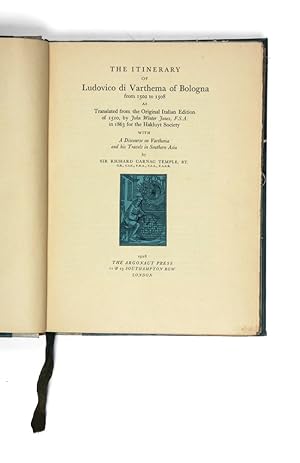
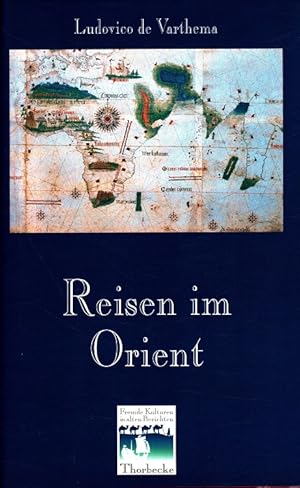
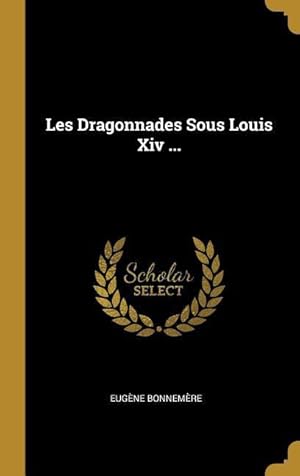
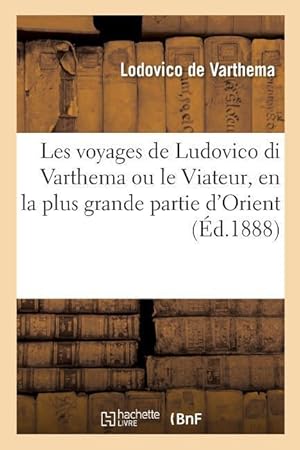

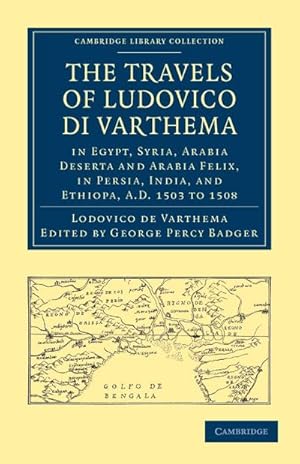
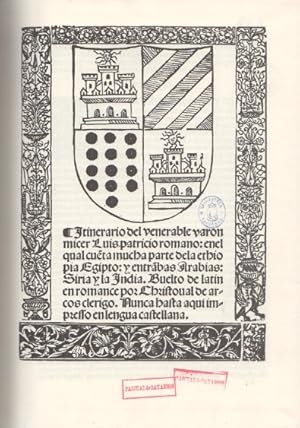
![Bild des Verkäufers für Hodaeporicon Indiae Orientalis; Das ist: Warhafftige Beschreibung der ansehnlich lobwürdigen Reyß, welche der edel, gestreng und weiterfahrne Ritter, H. Ludwig di Barthema von Bononien aus Italia bürtig, in die Orientalische und Morgenländer, Syrien, beide Arabien, Persien und Indien, auch in Egypten und Ethyopien, zu Land und Wasser persönlich verrichtet [.]. zum Verkauf von Antiquariat INLIBRIS Gilhofer Nfg. GmbH](https://pictures.abebooks.com/inventory/md/md18492590127.jpg)
![Bild des Verkäufers für The Navigation and v[o]yages of Lewes Vertomannus, Gentelman of the citie of Rome, to the regions of Arabia, Egypte, Persia, Syria, Ethiopia, and East India, both within and without the ryver of Ganges, etc. In the yeere of our Lorde 1503. Conteynyng many notable and straunge thinges, both hystoricall and naturall. Translated out of Latine into Engylshe, by Richarde Eden). zum Verkauf von Antiquariat INLIBRIS Gilhofer Nfg. GmbH](https://pictures.abebooks.com/inventory/md/md15723853044.jpg)
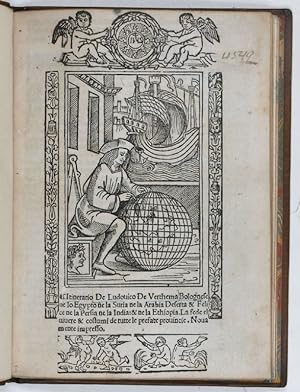
![Bild des Verkäufers für Die Ritterlich und lobwürdig reiß [.] Sagend von den landen, Egypto, Syria, von beiden Arabia Persia, India und Ethiopia, von den gestalten, sitten, und dero menschen leben und glauben. zum Verkauf von Antiquariat INLIBRIS Gilhofer Nfg. GmbH](https://pictures.abebooks.com/inventory/md/md30220668703.jpg)
![Bild des Verkäufers für Die Ritterlich und lobwürdig reiß [.] Sagend von den landen, Egypto, Syria, von beiden Arabia Persia, India und Ethiopia, von den gestalten, sitten, und dero menschen leben und glauben. zum Verkauf von Antiquariat INLIBRIS Gilhofer Nfg. GmbH](https://pictures.abebooks.com/inventory/md/md11801165564.jpg)

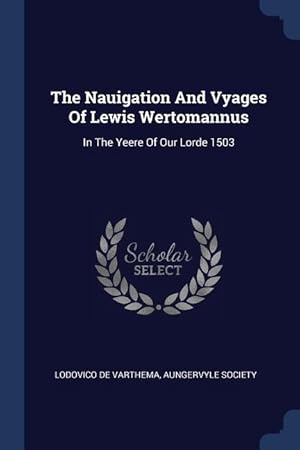

![Bild des Verkäufers für The Travels of Ludovico di Varthema in Egypt, Syria, Arabia Deserta and Arabia Felix, in Persia, India, and Ethiopia, A.D. 1503 to 1508 [.]. zum Verkauf von Antiquariat INLIBRIS Gilhofer Nfg. GmbH](https://pictures.abebooks.com/inventory/md/md31137212992.jpg)